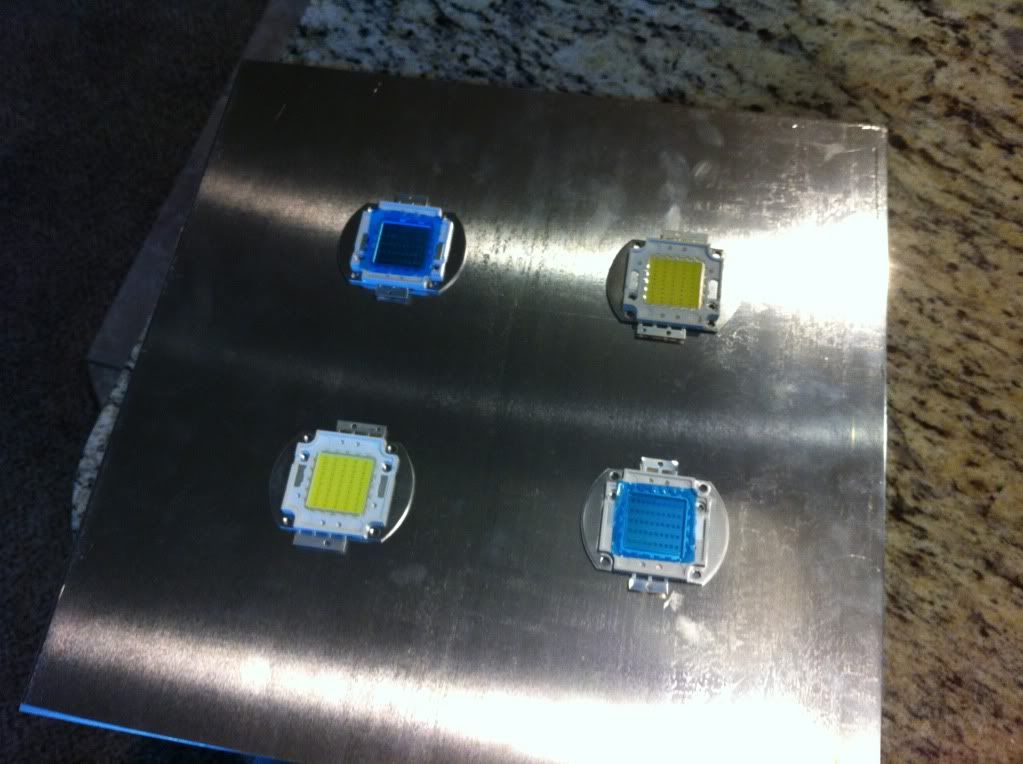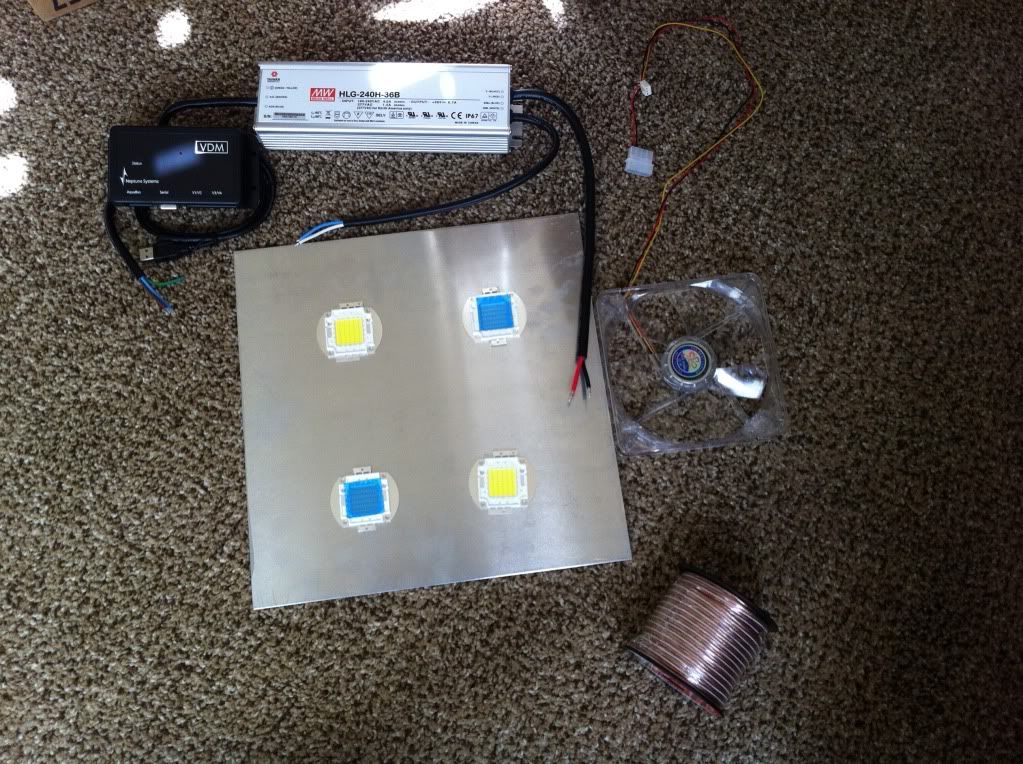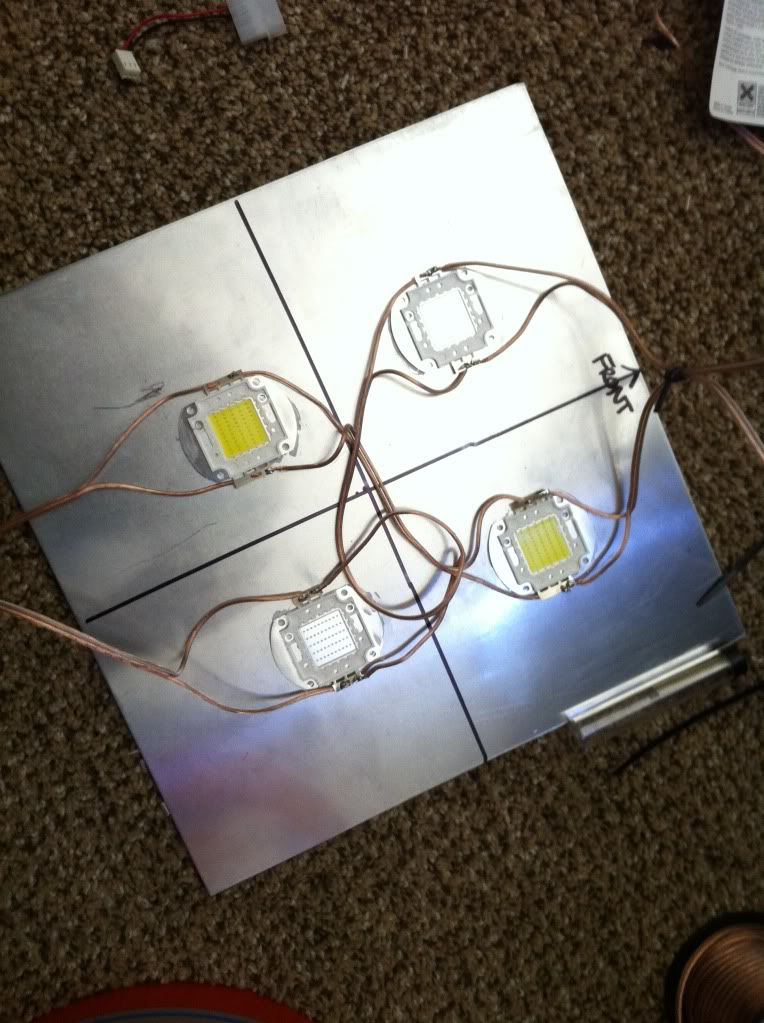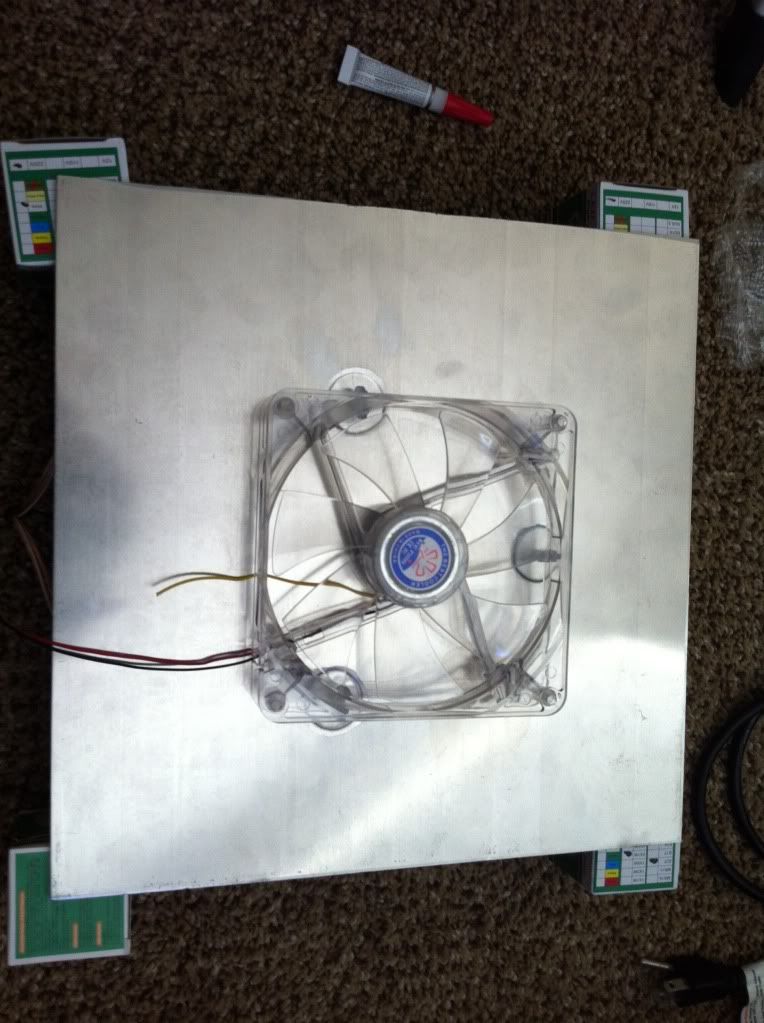


|
 |
|
|
#1 |
|
Registered Member
Join Date: Sep 2011
Location: A little place called summer heights
Posts: 72
|
New Approach multichip LED build
While experimenting with multichip leds one of my first builds was two 20W leds over my 6 gallon nano. That build took place almost 3 years ago well before i knew anybody using more than 3w leds for reef tanks. you can see the video
I'm happy to let everyone know that the multichip leds are still going strong! Recently I have purchased a 90 Gallon and I wanted to try a different theory behind the build. Most leds 50W and over require their own dedicated heatsink. While doing a cost analysis I figured that if you can consolidate the leds onto one heatsink it would be more cost effective to run multiple leds on the same heatsink. To explain this theory further I'm going to use a simple analogy. 1 led @ 100% capacity = 100 lumins and A lot of heat 2 leds @ 50% capacity = over 100 lumins and not as much heat as the first I'm not an electrical engineer but, this has been my experience. With this new build I decided to test my theory out... and it works.  I started out with 2 50W white leds, and 2 blue 50W leds on a 12"x12" 1/8" thick piece of aluminum which cost me a total of $14 and a 140mm fan from ebay ($4.50)    This time i decided to go away from the DIY arduino platform and buy an apex jr. w/ VDM... although the dimming is not quite as good as the PWM from the arduino but, it is sufficient. The build is now finished and i will be posting videos of the lights hopefully tomorrow. I know the cooling doesn't look sufficient but, I'm not running the leds @ 100% I'm running them at 10% and the light might still bleach some corals. I have made two of these fixtures and they will both go over my 90 gal. These lights can run at around 65% before they overwhelm the heatsink/fan cooling power. (it gets too hot for me to touch) I sure if i ran the leds even close to 65% I would torch everything. If you have any questions please feel free to ask. Overall costs savings compared to dedicated heatsinks = about $150. |
|
|

|
|
|
#2 |
|
Registered Member
Join Date: May 2009
Location: Lebanon Tn
Posts: 255
|
Is your 90 standard dimensions? I have a 110 it is 30 inches tall. I am wanting to redo my LEDs. Have you tested par? Being my tank is so deep should I stick with the 3w LEDs because I can put optics on them? Can you put optics on the 50w?
|
|
|

|
|
|
#3 |
|
Registered Member
Join Date: Sep 2011
Location: A little place called summer heights
Posts: 72
|
I dont have a PAR meter, and yes the tank is standard dimensions. When I get a chance to post a video you can see the light that hits the sandbed and I don't have any kind of optics on the LEDs. They do have 50w LEd optics if you need them but according to the configuration I'm using you would not need them. What are you planning on for a configuration? 4x50w LEDs per panel?
|
|
|

|
|
|
#4 |
|
Registered Member
Join Date: Aug 2004
Location: chicago
Posts: 6,434
|
great video. i like the lightning in the nano.
|
|
|

|
|
|
#5 | |
|
Registered Member
Join Date: Oct 2006
Location: Barrie, Ontario, Canada
Posts: 6,639
|
Quote:
assuming you are talking about 50W leds in both scenarios, then you will have the same amount of heat and most likely less light, at the very least everything will be the same... there are far too many math equations here that i dont have the foggiest idea about understanding, however i do know that energy cannot be created or destroyed... your 50W LED at 100% is going to produce a certain amount of light and a certain amount of heat, from what i have been reading the best scenario would be 30% light and 70% heat. that would be 35W of heat and 15W of light... your two leds would then be half that since they are at half power, then double since there is two of them...so 1 50W led at 50% power would output about 17.5W of heat and 7.5W of light which equals 25W, times two as there are two lights you would be right back at 50W... this is where the silly math comes in whereby the LED's efficiency increases slightly as the power to it is reduced but it will always be equal to the 50W or percentage of the LED you are actually using...and at some point or another the light is absorbed and transformed back into heat... LOL i could also be way out in left field here and talking straight out my wahzoo, but that is just my understanding of the situation...i would like to see this light in action though... |
|
|
|

|
|
|
#6 |
|
Registered Member
Join Date: Sep 2011
Location: A little place called summer heights
Posts: 72
|
like I said I also don't have the "foggiest!" but, I have my vdm set to 1%... literally 1% for blues and whites and the light output that I get is brighter than 40 watts on my 6 gallon nano and the back of the heatsink isn't even warm.
My approach is that the leds themselves are cheaper than individual heatsinks. why not buy more leds run them at lower power and spread out the heat on the cheap piece of aluminum than to power the leds at a higher percentage, decrease the life and spend the big bucks on individual heatsinks for your multichip? Like I said the equations are obviously not any kind of electrical engineering math, its just a simple analogy of how I approached this DIY LED build, spread the heat out, de-power the leds and add more. Video coming soon! |
|
|

|
|
|
#7 |
|
Registered Member
Join Date: May 2009
Location: Lebanon Tn
Posts: 255
|
I found 50w hybrid multichips. They are part 10-14k and 455. I am going to order 2 of them to get an idea on color and coverage. I am just worried that I wont get sufficient par to the bottom of my tank because the LEDs have 160 degree lens.
|
|
|

|
|
|
#8 |
|
Registered Member
Join Date: May 2009
Location: Lebanon Tn
Posts: 255
|
I thought about trying the 10w with optics. I found 2 of the hybrid 10w LEDs with drivers for $30. It's worth a try I guess.
|
|
|

|
|
|
#9 |
|
Registered Member
Join Date: Sep 2011
Location: A little place called summer heights
Posts: 72
|
On my nano I have a 20W hybrid. Its the same size as the 10W and it does produce a nice color. One of the problems that I have had after about a year and a half of use is the blue leds (455nm) on either side of the 10ks sometimes short out and flicker. I dont know why this is? The heat dissipation is sufficient as I dont run the led at 100%. Just a word of caution. I think the optics if you need them are the same price for the 10-20-50w leds
|
|
|

|
|
|
#10 |
|
Registered Member
Join Date: Jun 2012
Posts: 80
|
nope, it stands; LEDs are more efficient when run at lower power, so if you run two 50W LEDs at 25W instead, then will probably produce a slightly higher % of light than when they were run at full power (10%-20% or so more efficient)
for example, look at lumens per watt on the cree xpg datasheet: ~114 lumens/watt @ 2W versus ~97 lumens/watt @ 3.15W if your lumens per watt go up, then your fixture is now producing more visible light per unit of input power and accordingly per unit of heat the down side to all this is you now take up more space (not a problem for an application like this where overhead real-estate is not in super high demand) and also takes more parts (costs more $) |
|
|

|
|
|
#11 | |
|
Registered Member
Join Date: Jun 2012
Posts: 80
|
Quote:
|
|
|
|

|
|
|
#12 |
|
Registered Member
Join Date: Sep 2011
Location: A little place called summer heights
Posts: 72
|
I think the flicker problem is due to a short in the actual LED array. When they turn on the blues are visibly on but later in the cycle they seem to go out... must be a short in the led panel itself because the white are still on IDK?
Thank you Nyquist for coming up with some data backing my observations. I will however correct you on the $ part... I spent substantially less money consolidating the leds on one heatsink and just buying more led panels than to individually mount each led on a dedicated heatsink. I found that an adequate heatsink cost more than an led panel therefore the project came out to be less expensive. Space can be a concern but, when you consider two ai units are bigger than one of my 12"x12" heatsinks you could say it saves a bit of space? the panels are also really thin. the 140mm fan is what makes up the bulk of its thickness. Thanks again Nyquist for the DATA!!!! 
|
|
|

|
|
|
#13 |
|
Registered Member
Join Date: Sep 2011
Location: A little place called summer heights
Posts: 72
|
sorry it took so long... here is the video. Although the tank is still new and no livestock has been placed in it, the cycle is underway. As you can see 1% is pretty bright!
|
|
|

|
|
|
#14 | |
|
Registered Member
Join Date: Jan 2004
Location: San Francisco
Posts: 9,103
|
Quote:
That said, I wouldn't be terribly happy with the "slab-o-metal" heatsink which looks like in the pictures, surface area is your friend here, and you get it with fins.
__________________
Mike |
|
|
|

|
 |
| Tags |
| 90 gallon, diy led, led multichip, meanwell, reef led |
|
|